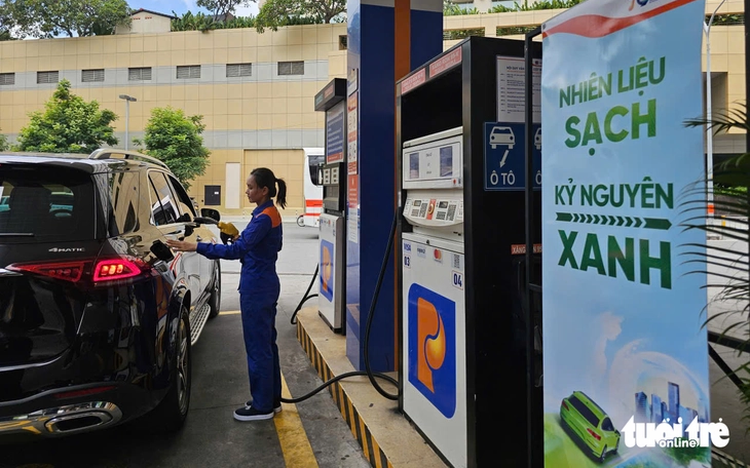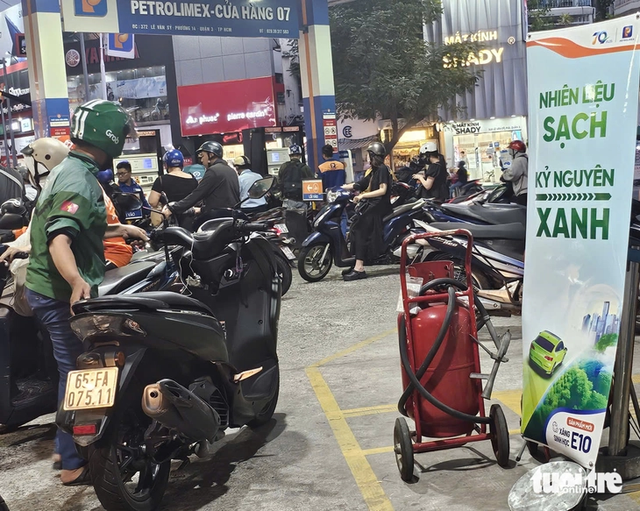
Vietnam National Petroleum Group (Petrolimex) began piloting the sale of E10 biofuel at its petrol stations starting August 1, 2025. Photo: Nhat Xuan / Tuoi Tre
E10 biofuel, consisting of 10 percent bio-ethanol blended with 90 percent fossil gasoline, is considered an important solution for reducing CO₂ emissions, promoting the ethanol agriculture sector and diversifying energy sources.
According to the government’s roadmap, E10 biofuel will gradually replace fossil gasoline.
At several gas stations in Ho Chi Minh City, E10 pumps have been installed alongside traditional fuels like RON 95.
However, due to its novelty, only a small number of customers are proactively choosing E10.
E10 is currently priced at about VND19,600 (US$0.7) per liter, roughly VND240 cheaper than RON 95-III.
Despite the price advantage and environmentally friendly message, the small cost difference has not been enough to convince most consumers to change their long-standing fuel preferences.
Nguyen Dinh Phong, 41, a resident of Ho Chi Minh City, told Tuoi Tre (Youth) newspaper that he had heard about E10 in recent days but was still hesitant to try it.
"I heard E10 is green fuel and good for the environment. But I’m not sure about its performance or whether it affects the engine. My vehicle is new, so I’m concerned it might not be compatible," he said.
Phong shared that he and many of his acquaintances are still wary, especially after reading conflicting opinions online.
"My friends still stick with the old fuel. I often check information on TikTok, Facebook, or car enthusiast groups, but the information is overwhelming and confusing," he added.
Similarly, Tran Phu, 24, also from Ho Chi Minh City, said he had read many posts and comments about E10 online but could not tell which were accurate.
"Some say it saves fuel and is good for the engine, others claim it causes corrosion. I want to support green products, but I still have concerns," he said.
Although Phu has tried E10, he admitted he did so just to see what it was like and still worries about its stability and compatibility.
Sales increase gradually
At a gas station on Phan Dang Luu Street, the station manager reported that on the first days of the E10 rollout, daily sales averaged only about 200 liters, accounting for a small fraction of total fuel sales.
“Most customers are still in the trial phase. They ask questions, listen to explanations, then smile and go back to choosing RON 95 because they’re worried their vehicles aren’t familiar with the new fuel,” the manager said.

A petrol station on Le Van Sy Street in Ho Chi Minh City displays a sign reading 'E10 Fuel – Environmentally Friendly' in a prominent location to boost visibility. Photo: Nhat Xuan / Tuoi Tre
Still, there are encouraging signs: E10 sales have been steadily increasing, and more customers are showing interest in the new fuel.
The station continues to actively educate consumers, assigning staff to E10 pumps to answer questions and installing clear signage and promotional stands. Some former users of E5 biofuel are also returning to try the new E10.
The manager hopes demand will rise significantly starting in September, when students return to school and transportation needs increase. However, they believe stronger, official communication campaigns are necessary to build public confidence.
According to Associate Professor Dr. Do Van Dung, former rector of the Ho Chi Minh City University of Technology and Education, consumers need to understand E10’s technical characteristics to use it safely and effectively.
He noted that ethanol has strong hygroscopic properties, meaning it readily absorbs moisture from the air, which can corrode metal parts like fuel pumps, pipes, and cylinders.
“Domestic research shows that if [ethanol is] not used properly, the engine lifespan of older vehicles could decrease by 20–30 percent,” he warned.
However, Dung also emphasized that most cars manufactured in 1998 use corrosion-resistant materials and are compatible with biofuel. In fact, many modern vehicles produced in 2010 have been specifically designed to run efficiently on E10.
For motorcycles, most newer models are compatible with E10, but older ones require regular maintenance and monitoring for unusual signs to ensure safety.
According to the European Automobile Manufacturers' Association, all gasoline cars manufactured from 2000 onward can safely use E10.
In Vietnam, brands like Toyota, Honda, and Ford confirm that models from 2011 and later are fully compatible.
For motorcycles, Honda, Yamaha, and Harley-Davidson models produced from 1986 onward can use E10, provided the fuel is not stored too long in the tank.
Older motorcycles (pre-1986) and certain older European cars like some Alfa Romeo models made before 2011 require special caution.
In Vietnam, older vehicles like early-generation Honda Dream or Wave motorcycles, or used imported cars, should be thoroughly checked before switching to E10.
If compatibility is uncertain, consumers are advised to use E5 or premium fuel alternatives.


Max: 1500 characters
There are no comments yet. Be the first to comment.